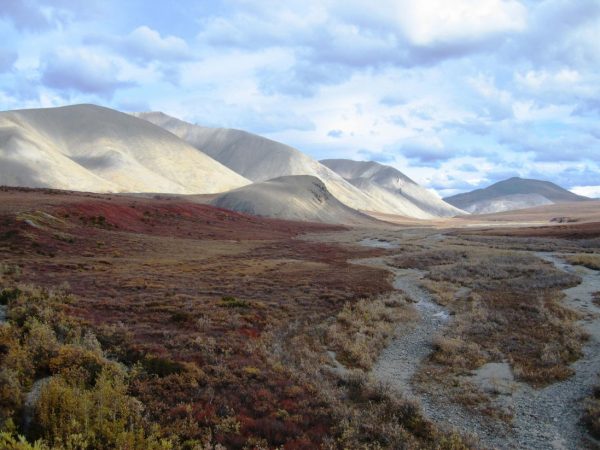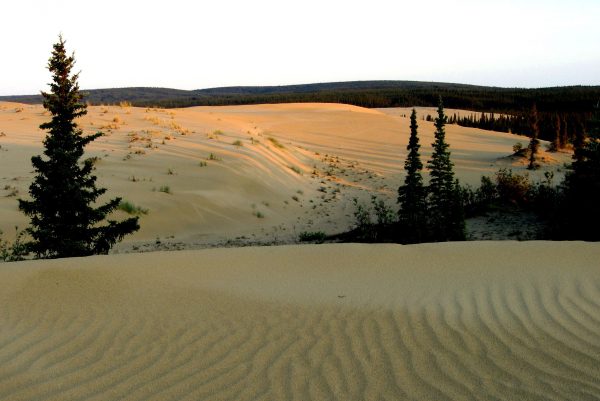Far from the hustle and bustle of other Alaskan destinations, the untamed nature of Kobuk Valley National Park allows you to experience “Wild Alaska” on its own terms.
There are many possibilities for adventure. You can boat down the languid Kobuk River, feel the thrill of a bush airplane flight, or chart your own backcountry trip.

Kobuk River in Kobuk Valley National Park. Photo courtesy of Western Arctic National Parklands
Whatever experience you plan, please remember to leave cultural artifacts and natural features as you find them. That helps everyone feel like they are the first person to set foot on that ground.
Kobuk Valley’s visitor isn’t your average tourist.
Mailing Address:
PO Box 1029
Kotzebue, AK 99752
Phone: (907) 442-3890They tend to be skilled backcountry explorers familiar with surviving wind, rain, and snow – and that’s in the summer months. Winter visits are recommended only to outdoorspeople experienced in arctic camping and winter survival techniques. For visitors with the right skills and gear, it’s a trip of a lifetime.
Limited Services Are Available
You’ll find no roads, no gift shops, and no parking facilities within Kobuk Valley National Park. Trails don’t exist; neither do campgrounds. Not even the park headquarters or visitor center are within the park. Both of these facilities are in Kotzebue, Alaska.
Access and services here are limited when compared to traditional national parks you may have visited elsewhere. What the area may lack in services, it more than makes up for in friendly people and an uncrowded wilderness experience. Rangers can provide advice on logistics to help travelers begin planning their trips.
Commercial businesses offer various services such as air taxis, guided rafting, and hunting. Air taxis offices are located in Kotzebue and Bettles.
Commercial airlines provide service from Anchorage to Kotzebue, or from Fairbanks to Bettles. Once in Kotzebue or Bettles, you must fly to the park with authorized air taxis. From Kotzebue, commercial airlines provide regularly scheduled flights to villages near the park.
Summer access may include motorized/non-motorized watercraft, aircraft, or by foot. Some visitors bring their own packable boats and have pilots drop them off to start a float through the park.
Study a topographic map, then talk with a pilot to decide on a feasible backcountry landing spot. Or plan to fly the boat as cargo on a small commercial plane to the villages of Kobuk, Shungnak or Ambler to start a trip on the Kobuk River.
The take out and flight home can be from the villages of Kiana or Noorvik. Hiking into the park from Kotzebue or Bettles is possible, but it’s a wilderness trek over rough terrain that requires many weeks to complete.
Winter access may include aircraft, snowmobiles or by foot. Small commercial planes fly to the local villages year round, weather permitting.
Chartered aircraft may be able to land at backcountry sites on skis when the weather is clear. There are no local equipment rental services in Kotzebue.
With advance planning, visitors can bring their own skis, snowshoes, dogteam or snowmobiles to travel into the park. Any winter trip requires advanced knowledge of cold weather survival.
History & Culture

Great Kobuk Sand Dunes. Photo courtesy of Western Arctic National Parklands
Kobuk Valley National Park has been home to humans for as long as there have been people on this continent. During the last Ice Age, the valley remained free of ice and teamed with big game, including the woolly mammoth.
Some of America’s very first inhabitants called Kobuk Valley their home. At a wide bend in the Kobuk River called Onion Portage, archeologists have found evidence that for at least 9,000 years, the caribou herd has been crossing the river there during their annual migrations. For just as long, humans have been gathering there to hunt them.
Excavations by archeologist Louis Giddings and others found evidence of nine distinct cultural groups who camped at Onion Portage, providing a window in time stretching back ten thousand years.
The dig at Onion Portage established the cultural timeline used for the entire region. It remains one of the best dated, continuously occupied sites in North America, as well as one of the oldest, and is considered one of the most important archeological sites in the Arctic.
History isn’t just a thing of the past in Kobuk Valley though. Canoes and spears have been replaced by motor boats and rifles, but the local Inupiaq Eskimos still hunt the caribou as they cross the Kobuk River at Onion Portage, just as their ancestors have done for ten thousand years.
Salmon and sheefish runs are still an important source of food, and in late summer, local residents head to the tundra to pick berries to last through the long winter.
Even in the age of modern conveniences, people still rely on the land to feed their families, just as they have done for thousands of years. Kobuk Valley has been home to Arctic civilization since the last Ice Age and here, that culture still lives on.
Visiting the Great Kobuk Sand Dunes

The Great Kobuk Sand Dune. Photo courtesy of Western Arctic National Parklands
Kobuk Valley National Park is encircled by the Baird and Waring mountain ranges. The park provides protection for several important geographic features, including the central portion of the Kobuk River, the 25-square-mile Great Kobuk Sand Dunes, and the Little Kobuk and Hunt River dunes.
A trip to the Great Kobuk Sand Dunes takes some effort, but the scenery and solitude makes it worth the work. There are no roads or trails, so plan to hire a pilot to get there. You can do an overflight, or land and stay a while.
The Arctic calls to mind images of windswept tundra and barren fields covered in snow, but Kobuk Valley National Park, located 35 miles above the Arctic Circle, is anything but stark and desolate.
The mighty boreal forest reaches its northern limits here before giving way to the rolling expanse of the arctic tundra, creating an open woodland of birch and spruce carpeted with moss and caribou lichen.
The park is bisected by the Kobuk River, which slowly meanders its way across the landscape for 61 miles. To the north of the river stretch the peaks of the Baird Mountains, while to the south lie the Great Kobuk Sand Dunes, the largest active sand dunes in the Arctic.
The Great Kobuk Sand Dunes, along with the smaller Little Kobuk Sand Dunes and Hunt River Sand Dunes, are a relic of the Ice Age. Sand and silt created by the glaciers’ slow grind across the land were washed into the valley during the last Ice Age, resulting in a scene that wouldn’t look out of place in the Sahara.
Sand dunes soar up to 100 feet high, and in the summer the temperature can top 100 degrees.
Sand created by the grinding action of ancient glaciers has been carried to the Kobuk Valley by both wind and water.
Dunes now cover much of the southern portion of the Kobuk Valley, where they are naturally stabilized by vegetation. River bluffs, composed of sand and standing as high as 150 feet, hold permafrost ice wedges and the fossils of Ice Age mammals.
The Great Kobuk Sand Dunes are the largest active sand dunes in the Arctic.
Plants & Wildlife

Caribou crossing river in Kobuk Valley National Park – Buy this print
A quarter million caribou migrate through the Park twice a year – north in the spring, south in the fall. Their tracks crisscross the 25 square miles of the Great Kobuk Sand Dunes. The lofty dunes are a sculpted desert in the middle of a wilderness of wetlands. The Kobuk River on the north side of the dunes winds roughly 61 miles through the park, providing a travel path for people and wildlife.
Onion Portage is a National Historic Landmark on the Kobuk River where people have gathered for 9,000 years to harvest caribou as they ford the stream. Today, local Alaskan residents still feed their families with caribou from the river crossing in the fall.
During the short summer months, Kobuk Valley teams with life. Bears lumber across the tundra in search of a berry patch, while foxes and wolves roam the woods, looking for their next meal.
Ducks, loons, geese and swans flock to the rivers and lakes to breed, and the Kobuk River and its tributaries team with salmon and sheefish.
Kobuk Valley National Park is home to the Kobuk Locoweed, a flowering herb that is only found on the slopes of the Great Kobuk Sand Dunes. It is also home to plants that weathered the last Ice Age in the sheltered, ice free valley.
Kobuk Valley now provides a rare glimpse into the ecosystem of Beringia, the thousand mile wide expanse of grassland that connected Asia and North America during the last Ice Age. 15,000 years ago, woolly mammoths and saber-tooth tigers once roamed the valley in place of today’s moose and grizzly bears.
Kobuk Valley is a wild land, untrammeled and untamed by human interference. It is a land more heavily traveled by caribou than by humans, where it’s possible to travel for days without seeing another person.
In Kobuk Valley, the natural world carries on its timeless cycle as it has always done in one of the late truly wild places, but no land, no matter how remote, exists in a vacuum.
Human activity around the world is rapidly changing the global climate, and that change has had more of an impact in the Arctic than anywhere else in the world. In this rapidly changing world, it remains to be seen how much longer Kobuk Valley can stay a land unspoiled by humans.
